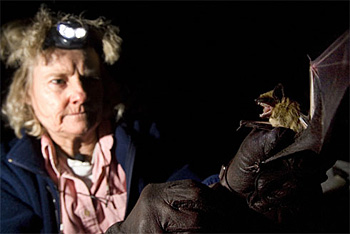 |
 |
 |
 News Around the Republic of Mexico | December 2007 News Around the Republic of Mexico | December 2007  
Drug Smugglers Curtail Scientists' Work
 Chris Hawley, USA TODAY Chris Hawley, USA TODAY
go to original


| | Karen Krebbs nets a bat at Arizona's Chiricahua National Monument in May. She since has abandoned research near the Mexican border. "I'm just not willing to risk my neck anymore," Krebbs says. |
Mexico City — Biologist Karen Krebbs used to study bats at Organ Pipe Cactus National Monument on the Arizona-Mexico border. Then she got tired of dodging drug smugglers all night. (Pat Shannahan,/The Arizona Republic)

"I use night-vision goggles and you could see them very clearly," Krebbs said of the caravans of men with guns and huge backpacks full of drugs, trudging through the desert. After taking refuge in bushes or behind rocks on 10 or so occasions, Krebbs abandoned her research. "I'm just not willing to risk my neck anymore," she said.

Along the U.S.-Mexican border, scientists like Krebbs say their work is under growing threat from drug traffickers and other criminals who have been pushed into remote areas by tighter U.S. border security.

Richard Felger, a botanist, said he stays away from remote mountains in the Mexican border state of Sonora after being robbed and threatened on research trips.

"I got kind of allergic to pistols being held to my forehead," Felger said.

There are no statistics on how many scientists have been attacked or threatened, said Mark Frankel, director of the scientific freedom program at the American Association for the Advancement of Science. But among researchers, stories of theft and armed robbery are common.

"In the last year it has gotten much worse," said Jack Childs, who studies endangered jaguars in eastern Arizona with infrared cameras. He loses one or two of the cameras every month to smugglers.

Childs has tried leaving notes and pictures of saints — even Jesús Malverde, the unofficial, folklore saint of drug traffickers — to try to persuade smugglers to spare his cameras, but to no avail. Each camera costs $450.

Scientists long have shared the border area with marijuana growers and immigrants trying to enter the USA illegally. But tension is rising because of a crackdown on smugglers by the Mexican military, new border fences, patrols by unmanned planes, a buildup of U.S. Border Patrol agents and a turf war between cartels.

"It's a kind of arms race, and biologists are stuck in the middle," said Jim Malusa, who specializes in mapping desert vegetation. "There has been a chilling effect on researchers."

Michael Wilson, a botanist and director of research at the Drylands Institute in Tucson, said he avoids some parts of Mexico's Sonora state after seeing opium poppies, which are not native to Mexico, and mules carrying loads of marijuana down from the mountains. Opium resin is used to make heroin.

Wilson said he has noticed an increase of marijuana cultivation in recent years, and more people watching over the fields. Some of his colleagues now carry guns, he said.

"There are a lot of researchers who have ducked out of doing research in Mexico," Wilson said.

Scientists working at sea have also had their work disrupted.

Jeffrey Seminoff, an ecologist with the U.S. National Marine Fisheries Service, said smugglers have robbed boat fuel from his researchers at gunpoint in the Gulf of California, leaving them just enough gas to get back to shore.

In May, Seminoff stumbled across a camouflaged drug boat in a cave near San Carlos, Sonora, while setting nets for sea turtles.

"They definitely had guns, so we just kind of backed off. So one of our primary turtle capturing sites we had to abandon for the day," he said.

One day can be a serious loss to researchers, who are often short of time and grant money.

Anglers are increasingly getting involved in drug smuggling because Mexican fisheries have collapsed, said Wallace J. Nichols, a marine biologist at the California Academy of Sciences. He used to collect much information on sea turtle sightings from fishing boats off Baja California but now avoids boats that look too new.

The resulting paralysis is creating gaps in scientific knowledge, researchers complain.

Huge swaths of northwestern Mexico are now off-limits to science, said Andrés Búrquez, a professor at the National Autonomous University of Mexico. "The most serious problem is when you have to visit a specific place in the countryside, places of geological interest," he said. Residents "will say, 'You can go to A, B and C place, but not D.' And it turns out that's the place that interests you most."

Dean Hendrickson, an ichthyologist at the University of Texas, says avoiding marijuana and poppy fields has set back his efforts to study mysterious species of Mexican trout in Chihuahua state.

"This sort of stuff definitely puts holes in our sampling," Hendrickson said. "The drug stuff is definitely affecting research."

Hawley is Latin America correspondent for USA TODAY and The Arizona Republic | 
 | |
 |



